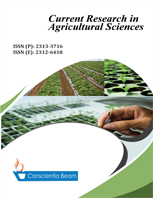Evaluate the Competitive Interactions among Component Crops in Cassava-Legume-Based Intercropping Systems
DOI:
https://doi.org/10.18488/cras.v9i2.3092Abstract
Competition among component crops in an intercropping system is an important factor that influences productivity. To realize the benefit of intercropping in terms of higher productivity per unit area, the competitive behaviour of component crops needs to be quantified. As such, an experiment was conducted to determine the competitive behaviour of component crops in cassava-legume-based intercropping systems. The experiment was a factorial randomized complete design with three replications. The treatments consisted of seven cropping associations and two spatial arrangements. The result shows that both land equivalent ratio and area time equivalent ratio was greater than one and was higher for the cassava-soybean system compared to the other cropping systems. In general, the land equivalent ratio was higher than the area time equivalent ratio across the three agro-climatic zones. In the case for the competitive ratio and the relative crowding coefficient, both indices were higher for cassava compared to the legumes and were also higher for the cassava-soybean system compared to the other cropping systems. Also, both indices were on average higher when the legumes were intercropped with cassava using the 2 m x 0.5 m spatial arrangement. The result further shows a higher monetary advantage index for all cropping systems compared to monocropping. In conclusion, it was shown that, cassava-legume-based intercropping systems were advantageous in terms of both competitive and economic indices.

